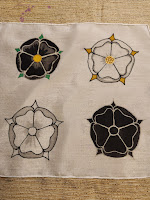To celebrate some big milestones in our family, we decided to splurge on a Rhine River cruise. We visited several cities in France, Germany and the Netherlands, but the big highlight was seeing the castles along the banks of the river.
Here's what we saw, in order as we cruised north from Rudesheim am Rhine to Cologne. Let's see how many of the numbers sights from this sign in Rudesheim we managed to get pictures of. I should mention that it was a very grey, cold and wet day. I got very wet out taking pictures and eventually gave up to enjoy the warm cabin on our boat.
33. Rudesheim am Rhine
18. Rochuskapelle
17. Bingen mit der Burg Klopp
32. Niederwalddenkmal
31. Ruine Ehrenfels
15. Mauseturm in Binger Loch
16. Bingerbruck
14. Burg Rheinstein
13. Trechtingshausen und Burg Reichenstein
30. Assmannshausen
12. Burg Sooneck
11. Heimburg
29. Lorch und die Ruine Nollig
10. Ruine Furstenburg
9. Bacharach "Wernerkapelle" und Berg Stahleck
28. Pfalzgrafenstein
27. Kaub und die Berg Gutenfels
8. Oberwesel und die Schonburg
26. Der Loreley-Felsen
25. St. Goarshausen und die Berg Katz (cat)
24. Wellmich und die Berg Maus (mouse)
7. St. Goar und Berg Reinfels
6. Bad Salzig
23. Kamp-Bornhofen mit den Burgen Sterrenberg und Liebenstein (the feuding brothers)
22. Osterspai und Schloss Liebeneck
5. Boppard und die Kurtrierische Burg
4. Spay
3. Rhens und der Konigsstuhl
21. Braubach und die Marksburg
20. Lahnstein und Burg Lahneck
2. Schloss Stolzenfel
1. Koblenz Kurfurstliches Schloss und "Alte Burg"
19. Festung Ehrenbreitstein
With the rain, it got dark early and it was dinner time, so we missed a few at the end. Overall, we saw 24 of the 33 on this the map at the top of this post and it was pretty cool to see so many. I just wish it was a little warmer.
We seem to have seen a few extras. Here's what I have been able to identify:
Apollinariskirche
Schloss Arenfels
Friedenmuseum















.jpg)





































